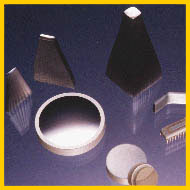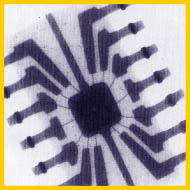| |
|
Capillaries
and Capillary Structures 
CHI
manufactures structures of collimated holes, also known as
capillary arrays. The concept of large plates of parallel
holes was an important part of the inspiration for the creation
of the company in 1975. Through our glass
drawing and etching processes,
we
produce arrays, disks, plates, and individual capillaries
with a wide range of capillary
diameters, geometries
and plate
sizes, all within certain
tolerances.
Capillaries
and capillary arrays can also be made using drawn tubes. In
general, drawn tube structures and arrays are not quite as
tightly packed and uniform as fused, etched structures; drawn
tubes are not limited by the length
to diameter ratio restrictions inherent in the etching
process, and they result in smoother interior
surfaces than those found in etched capillaries. Both
types of capillary structures have OAR’s
that can be adjusted from less than 1% to nearly 70%. Some
non-confidential applications
of capillary arrays are described herein.
Price
chart for standard Capillary Plates
|
|
Fiber
Optics 
Since
incorporation in 1975, CHI has been producing glass optical
fibers in small and large quantities
for special applications. We have built a wide base of glass
drawing experience over the intervening years with the
production of millions of miles of standard and custom fibers,
in an array of diameters, geometries,
OAR’s, numerical
apertures, and glass types.
We keep a wide variety of glasses, including our patented
terbium-doped scintillating glass, in stock to minimize lead
times and to optimize engineering flexibility.
By
stacking individual fibers into multi-fibers,
we are able to produce many types of fused fiber optics, such
as light guides, multi-fiber image
conduits, Fiber Optic Face Plates,
image remapping devices, and
fiber arrays. We also have the ability to add a layer of EMA
(Extra-Mural Absorbing) glass to the exterior of individual
fibers or between fibers in a fused fiberoptic, to reduce
light leakage and fiber cross-talk.
|
|
Scintillators

CHI
holds five patents on terbium-activated luminescent glasses.
From these glasses, we manufacture both bulk (non-fiber) and
fiber optic structures that convert non-visible, high-energy
radiation into visible, green light. Scintillating fiber optic
faceplates are commonly used as X-ray conversion screens for
industrial inspection systems. X-rays and other high-energy
radiation enter the scintillating glass and stimulate the
emission of green photons, and those that meet the total internal
reflection angle requirements are then transmitted along the
length of the fiber. Adding a mirror coating to the input
side can roughly double the light output of a scintillating
fiberoptic. The scintillating glass formulation has emission
peaks at 555nm and 565nm, and a decay time of 2ms to 40% value.
Emission
Spectrum and related data
Hybrid Scintillators for X-Ray Imaging Paper from SPIE 1996 (by Clifford Bueno, Richard L. Rairden, and Robert A. Betz)
Comparison of X-Ray Absorption, Light Output, and Afterglow in Glass FOS and Polycrystaline Scintillators
(by Clifford Bueno)
|
About
CHI | Products | Services
| Publications | Contact
CHI | Home
|

